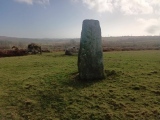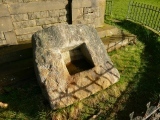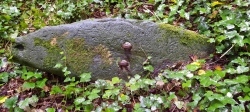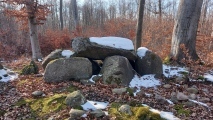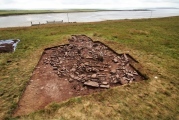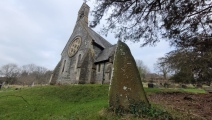Andy Burnham's Blog, page 33
February 25, 2025
3rd Stone Issue 32, Oct-Dec 1998 for Free Download
Newly scanned by ourselves for your reading pleasure. In this Issue:
• Rodney Castleden - Restoring Stonehenge
• George Children and George Nash - Climatic Triggers Within the Historical Record
• Allen Hunt - Millennium Mania
• Victor Reijs - Maes Howe's Megalithic Month Alignment
• Cornelius J. Holtorf - Christian Landscapes of Pagan Monuments
• H. S. Chapman - 'Arrow Stones' and Related Phenomena: North Wales Examples of Prehistoric Art
• David Kaiser - Stonehenge American Style
• Rodney Castleden - Restoring Stonehenge
• George Children and George Nash - Climatic Triggers Within the Historical Record
• Allen Hunt - Millennium Mania
• Victor Reijs - Maes Howe's Megalithic Month Alignment
• Cornelius J. Holtorf - Christian Landscapes of Pagan Monuments
• H. S. Chapman - 'Arrow Stones' and Related Phenomena: North Wales Examples of Prehistoric Art
• David Kaiser - Stonehenge American Style
Published on February 25, 2025 10:15
February 24, 2025
Park Head Fort
The remains of a cliff castle or promontory fort at Park Head, north of Newquay. It occupies a narrow level promontory of approximately 1.9 acres and is defended by a bank with a rock-cut outer ditch and slight counterscarp. The ditch is causewayed but there is no corresponding gap in the bank.
Published on February 24, 2025 09:47
Maen Tyddyn Du
Situated along an ancient trackway this standing stone has an interesting history. The surrounding area has undergone a lot of land management over the years with stone clearances and field drainages adding their distinctive characteristics to this ancient landscape. From local history and a lengthy discussion with the landowner it appears that the stone was discovered lying beneath earth and overgrowth during some field maintenance about 30 years ago. Its location, size and shape convinced those involved that the stone had previously stood at that spot and a decision was taken to re-erect the stone regardless of its central position in the field.
Published on February 24, 2025 09:44
February 23, 2025
Holden Cross (Haslingden)
Leaning up against the clock tower in Haslingden’s Victoria Park is a huge, square cross base. This is the only surviving remnant of Holden Cross, which was situated to Holden Hall, off the Haslingden Grange Road. Many wayside cross bases are quite small, but this one is huge, measuring 50cm (22 inches high) and just over 1m (38 inches) square.
Published on February 23, 2025 02:24
Killin Circle
This site in Co. Louth was destroyed in 1826 when every stone was removed, crushed and rendered to lime mortar. It was documented as rivalling the carvings in Newgrange! The stone in the top photo was presumably one of the circle that surrounded the cairn. Being sandstone it was no use for lime mortar and was used as a gatepost It still has metalwork in it. It was returned to the site (early 1900's) and is the only remains in existence. There are vague carvings on the stone.
Published on February 23, 2025 02:17
February 21, 2025
3rd Stone Issue 31, July-Sept 1998 for Free Download
Newly scanned by ourselves for your reading pleasure. In this Issue:
• Jeremy Harte - Folk Memory
• Rodney Castleden - Stretching Credibility: A Perspective on the Long Man of Wilmington
• Alastair McBeath - Comet Myths Ancient & Modern
• David S. Whitley - Shamanism, Rock Art and Landscape Symbolism in Native California
• Frank Olding - Fairy Lore in 18th~century Monmouthshire
• E. C. (Ed) Krupp - Celestial Analogy and Cyclical Renewal
• Dylan Bickerstaffe - The Longest Screamin History
• Phil Quinn - An Unnatural History of the Bristol Region
• George Nash - Walking With Landscape Syntax and Narrative
• Jeremy Harte - Folk Memory
• Rodney Castleden - Stretching Credibility: A Perspective on the Long Man of Wilmington
• Alastair McBeath - Comet Myths Ancient & Modern
• David S. Whitley - Shamanism, Rock Art and Landscape Symbolism in Native California
• Frank Olding - Fairy Lore in 18th~century Monmouthshire
• E. C. (Ed) Krupp - Celestial Analogy and Cyclical Renewal
• Dylan Bickerstaffe - The Longest Screamin History
• Phil Quinn - An Unnatural History of the Bristol Region
• George Nash - Walking With Landscape Syntax and Narrative
Published on February 21, 2025 13:39
Forst Suckow Dolmen
Burial Chamber (Extended Dolmen) in Brandenburg. A small chamber, 2.5m long by 1.5m wide, North East to South West oriented, with 6 uprights and 2 capstones, one of which has slipped into the chamber.
Published on February 21, 2025 09:31
February 19, 2025
Spurness Early Bronze Age settlement
An Early Bronze Age structure in Spurness, excavated in 2018 and planned to be re-opened this August. The dig confirmed “double house” architecture as well as several other interesting elements. Dr Hugo Anderson-Whymark has created a 3D model showing the Bronze Age structures excavated in 2018, see the comments for details.
Published on February 19, 2025 02:12
February 18, 2025
Cenarth Churchyard
Standing Stone in Cenarth churchyard - also known as The Gellidywyll Stone.
It’s inscribed ‘CVRCAGN - FILI ANDAGELI’. Meaning Curcagnus, son of Andagelli.
Coflein says the stone is 5th to early 6th century.
It’s inscribed ‘CVRCAGN - FILI ANDAGELI’. Meaning Curcagnus, son of Andagelli.
Coflein says the stone is 5th to early 6th century.
Published on February 18, 2025 10:16
Montarbu
Nuraghe Montarbu, or Mont'arbu, is partly collapsed but still impresses the visitors thanks to its location and to the craftsmanship of the people who built it. Small stones are stacked against big boulders resting on the massive rocky outcrop of the hill top. Described as a complex nuraghe, it dominates the surrounding hills (and a natural rocky structure called Sa Mitra or Sphinx) all the way to the sea.
Published on February 18, 2025 10:15


